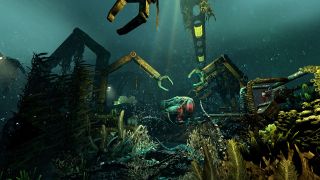Take note, developers: Soma's ‘Safe Mode’ is an essential option for players who value storytelling over stress
Dialling down the danger in Soma finally gives its high minded story the space it always needed to breath

Soma is one of the December 2018's free PS Plus games - if you're a subscriber, be sure to check it out!
Imagine trying to read a really good (but super complicated) novel while walking through a horror house. You've just got to a critical moment in the story, and you're trying to wrap your head around everything that just unfolded on the page, but before you can even begin to figure out the subtext of it all, some guy dressed as a clown jumps out from behind the corner shouting "BOO!", knocking you off track and forcing you to reread the entire scene from the beginning.
That's kind of what playing Soma was like when it first came out. Frictional Games’ interactive thought experiment dealt with weighty, complex issues surrounding the nature of mortality and consciousness, but its excellent story beats were splintered amongst frustrating stealth sections and cheap jump scares, brought about by the monstrous creatures inhabiting its world. I wasn’t the only one who felt this way, either. Head to the game’s store page on Steam, and you’ll find that its most popular mod is an update called Wuss Mode, which completely removes an enemy’s ability to attack the player.
Over the last two years, Frictional Games has clearly taken that feedback on board, as the recent Xbox One release of Soma now arrives with an optional ‘Safe Mode’ (also available as an update for the PC version and coming to PS4 next year), offering "the chance to explore the story without being eaten by monsters."
Safe Mode doesn’t remove Soma’s enemies from the game, but this time they no longer pose much of a threat to you, and that small but crucial change makes all the difference for players like myself. To understand why, though, you first have to understand the kind of game that Soma intends to be.

Taking place in a seemingly abandoned research facility at the bottom of the ocean (what is it with philosophical games and collapsed underwater communes?), Soma has you playing as a guy called Simon, who’s just woken up and is very confused as to what’s going on or why he’s even there.
Suffice to say, things are not as they seem down in PATHOS-II, but I won’t divulge the details, as part of Soma’s appeals stems from scratching away at its many layers and discovering each new revelation for yourself. Just know that the game has a lot of things to say about big, big subjects, with ruminations on the philosophy of the mind, memory, free will, artificial intelligence, and a library’s worth of other abstract ideas.
Sign up to the GamesRadar+ Newsletter
Weekly digests, tales from the communities you love, and more
"Replaying Soma in Safe Mode feels like driving an open highway without any speed bumps to slow you down"
All of these topics are explored through a provocative, often disturbing narrative, but it's a narrative set within an immersive sim that also wants to be a survival horror game, and that commitment to the latter often comes at the expense of the former when playing Soma in its classic mode.
Applying the lessons learnt from its other horror series, Amnesia, Frictional Games populates PATHOS-II with a host of predatory monsters, who are frequently spotted roaming the facility’s dingy metal halls and corridors, able to almost instantly kill the player if they’re not careful to avoid them.
It can be genuinely scary stuff, but running away from these monsters was never what made Soma interesting in the first place, and their ubiquity in the game’s original build come off as unwelcome interruptions to an otherwise enthralling mystery.

Fast forward to today, and replaying Soma in Safe Mode feels like driving an open highway without any speed bumps to slow you down. With the monsters now acting non-aggressively, I’m no longer beset with frustrated paranoia or constantly distracted by my own survival instincts. Instead, my attention is entirely focused on engaging with Simon’s personal journey and learning more about the history of PATHOS-II, as I’m able to digest the multi-faceted story with a clearer head and a more comfortable disposition.
Even in Safe Mode, though, Soma still has a decent scare factor to it, but it’s the kind of spookiness that actually brings further clarity to the themes and overtones of its story, as opposed to undermining them. The monsters might not attack you (at least most of the time), but the cold, empty stares they throw towards Simon only exacerbates the sense of existential dread that cakes the game’s claustrophobic environments and liminal atmosphere. Think of how Gone Home makes you nervous despite the fact that no danger ever befalls you, and you get the idea.
It’s within this slightly modified Safe Mode setting where Soma’s story finds new life. I was able to pick up on small details in the environment that I’d been too stressed to notice before, and instead of constantly worrying about staying alive as I wandered the facility’s labyrinthian structures, I was instead mulling over the meaty questions that the game kept throwing towards me. The background noise was gone and, just like that, Soma’s illuminating commentary bubbled to the fore.

As preferable as Safe Mode is for someone like myself, and indeed many others, it’s so important that Frictional Games has implemented it as an optional, alternative feature. Soma’s monsters may have been divisive at launch, but I’ve no doubt that there are plenty out there who do enjoy the game’s survival horror elements, and were perhaps even drawn to it specifically because of Frictional’s history with that genre.
But that’s precisely the point: by providing more than one way to play, Soma has become a more inclusive experience that can cater itself to varying tastes and speak to a wider number of people. It’s almost such a commonsensical addition, that it makes you wonder why so few games have tried something like this before.
Granted, for a lot of titles, it’s not as simple as turning off AI aggression. Take away the threat of Bioshock’s Big Daddies, for example, and you have a game that doesn’t really look like Bioshock anymore. That’s not to say it isn’t possible for an expansive, big budget game to find a way to make it work, though; just take a look at what Ubisoft is doing with Assassin’s Creed: Origins’ upcoming Discovery Tour mode. It just takes some time to figure out how to excise the danger without stamping all over the original creative vision of the game itself.
At the very least, the success of Soma’s Safe Mode can serve as an example for how developers can customise their experiences to appeal to those whose aren’t so interested in the challenge, the scares, or the digital dangers of interactive entertainment. A virtual world free from hazard is one built for the tourists, the detectives, the explorers, and the listeners, and once games can begin to more effectively recognise these kinds of players, they’ll be all the better for it.
I'm GamesRadar's Features Writer, which makes me responsible for gracing the internet with as many of my words as possible, including reviews, previews, interviews, and more. Lucky internet!
Most Popular





